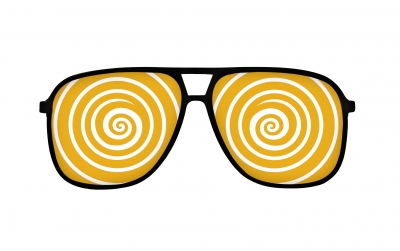Hypnosis is a popular and successful treatment for IBS. Ever wonder why?
I was extremely curious to find out, so I interviewed a local hypnotherapist and sampled a session.
I knew that hypnosis worked with the mind body connection and the subconscious mind (which I’ve written about here) but I wanted to learn how it helps IBS sufferers.
This is what I found out….
Hypnosis works by slowing down the brain and calming the nervous system. It addresses the emotional triggers of IBS by rewiring, healing and balancing the nervous system.
It does this by quieting down the conscious mind and speaking directly to the subconscious mind. It implants healthier thought patterns with targeted suggestions.These suggestions are simply affirmative statements about health or a positive belief.
When these suggestions are implanted and repeated, the functioning of the subconscious and the nervous system change over time.

How does hypnosis heal?
The subconscious mind and nervous system are in charge of much of the body’s involuntary functions like breathing, circulation, digestion, heart rate and perspiration. It also houses our creativity, intuition, emotions and identity.
The conscious mind helps us analyze, get things done, judge and create strategies. But our subconscious mind runs 90 percent of the show in our body. It determines how we breath, digest and our sensitivity to pain.
The conscious mind programs nervous system and subconscious functions with its thoughts. This is how your thoughts directly effect how your body works.
For example, if you think “I’m strong as an ox, I never get sick”, your subconscious mind will organize your body to prove this statement true by boosting immune function and creating feel good chemicals.
The reverse happens with thoughts like” I’m always sick and afraid I won’t heal”. Your subconscious mind will work its hardest to match your thoughts to reality.
What hypnosis is NOT
There’s a lot of misunderstanding and myths about hypnosis.
Under hypnosis people are not asleep or in a mysterious altered state. They are ultra relaxed, very focused and hyper aware. Under hypnosis no one can be forced to do something against their will. You can snap out of hypnosis at any time. You are always in control.
What happens under hypnosis
The hypnosis process is simple. You lie back in a comfortable chair as the hypnotherapist takes you through a guided imagery visualization. It typically starts by imagining yourself slowly walking up or down a flight of stairs.
When brain waves slow down to half their regular speed and the body relaxes and softens, you are under hypnosis. A typical response under hypnosis is to yawn, feel tingling in your limbs or fade in and out of hearing what’s said.
In this state the connection to the subconscious mind is direct and the nervous system is in deep healing mode. You have access to a part of yourself that can’t be reached consciously, it requires a deep state of relaxation to open yourself up to suggestion.
An example of a suggestion would be: “I’m able to digest my food without pain.”
The subconscious mind will hear this suggestion and start to transform based on the new information.
Because hypnosis rewires long standing patterns of thought it takes several sessions and dedicated home practice to create lasting change.
Hypnosis is a natural human state
We naturally fade in and out of hypnosis in our daily lives. This happens when our attention is totally absorbed by a single thought or activity. Some people call this being in a “flow” state.
If you’ve ever missed an exit on the highway because you’re deeply engrossed in thought, it’s because you put yourself into a hypnotic state. When your mind is focused on only one thing, everything else fades away. That’s hypnosis. But you’re still hyper aware and able to drive in that state of mind.
Self hypnosis
Meditating or meditative activities can also put you into a hypnotic brain state.
Examples of these meditative activities are yoga, running, meditation or qi gong. A favorite hobby, if engrossing enough, can also work. Regularly putting yourself in a self-hypnotic state allows the nervous system to deeply rebalance and heal itself.
Meditating on a positive thought, mantra or affirmation is also a form of self hypnosis.
The two times of day we are most connected to the subconscious mind is upon waking in the morning and before drifting off to sleep. These are the best time to repeat positive suggestions.
Why not just change chronic thought patterns without hypnosis?
It’s not that easy.
Chronic thought patterns become embedded in our nervous system and form neurological connections in our brain. Changing the flow of our thought patterns means changing the connections between our neurons.
These physical changes are very possible but require commitment and repetition. Hypnosis can speed up the process by talking directly to the subconscious and nervous system where these connections live.
The effectiveness of hypnosis also depends on the person. Some people are more easily hypnotized than others.
What I learned about the body from hypnosis
It was fascinating to try and demystify hypnosis.
I was expecting mystical things to happen. But I learned that hypnosis was simply a grounding practice that slows down the brain and relaxes the body so it’s ready for change. Hypnosis creates a link to the subconscious that allows it to shift slowly over time.
Hypnosis can shift the way our bodies respond to stress by taking us out of fight or flight mode and retraining us with new response options.
Hypnosis helps heal IBS by bypassing the mind and working directly with the body’s automatic functions and responses. Hypnosis talks to the digestive system and tells it how to better respond and relax. It can also desensitizing the intestines from feeling intense pain.
I learned that stress speeds us up, while hypnosis slows us down. In a slow state we have direct access to our innate healing power.
My hypnosis experience
I had a good experience with hypnosis. I chose to work on an old compulsive habit I’ve had for 20 years. I was ready to get rid of it.
I was amazed at how well it worked. After one session and a few days of repetition before falling sleep and upon waking my compulsive pattern was gone.
I am three weeks into the hypnosis experiment and still feeling the healing effects. I might have to go in for another session or do some self hypnosis to maintain my changes, especially if I encounter a lot of stress.
One of my favorite self hypnosis techniques is Yoga Nidra, which is a guided meditation done lying down. When my brain slows down into this meditative state, I will repeat the hypnotic suggestion.
For people who find hypersensitivity or stress to be an obvious trigger for IBS, hypnosis is a promising treatment.
Meditative activities can also be very healing, but hypnosis adds in targeted suggestion to enhance this powerful healing state.
 Angela Privin is proof that IBS is NOT an incurable disease or a disease at all. IBS is a body out of balance. It’s an invitation for change. After solving her own IBS mystery more than a decade ago Angela trained as a health coach to help others.
Angela Privin is proof that IBS is NOT an incurable disease or a disease at all. IBS is a body out of balance. It’s an invitation for change. After solving her own IBS mystery more than a decade ago Angela trained as a health coach to help others.
Angela uses both science and intuition to help people figure out what’s out of balance in their body. She works with lab tests, dietary changes, supplementation and nervous system rebalancing. Get help rebalancing your digestive system and solving your IBS mystery here.







10 Comments